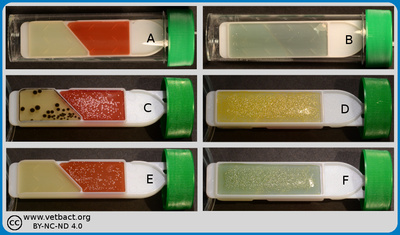Dip slideIn the first column (A, C and E) the figure shows the side of the dip slide (Uricult), which is covered by E. coli agar to the left and MacConkey agar to the right. The other side of the dip slide, which is covered by CLED agar, is shown in the second column (B, D and F) . Bacteria has not been applied in the first row (A and B). In the second row (C and D), Escherichia coli has been applied. In the third row (E and F), Proteus vulgaris has been applied. - Click on the image to enlarge it. Image: Karl-Erik Johansson (BVF, SLU) and Lise-Lotte Fernström (BVF, SLU).
Introduction:Dip slide is a test system for detection of microorganisms in liquids. The system consists of a tightly sealed plastic jar containing a slide with agar based culture media on one or two sides. The slide is immersed in the liquid to be analyzed. The liquid can also be flushed over the slide with a Pasteur pipette. The slide is then put back in its original container and incubated at the appropriate temperature for 1-2 days. Then the result is read. There are systems developed for different applications. In veterinary and human medicine dip slides are often used for analysis of urine samples. Dip slides for urine samples:There are several commercial systems developed for urine samples and in veterinary medicine, Uricult® Trio is often used in Sweden (see figure). In this system, one side of the slide is covered with CLED agar and half of the other side is covered with MacConkey agar and the other half is covered with E. coli-agar. Most pathogens of the urinary tract grow on CLED agar and if they are lactose fermenting, the colour of CLED agar changes from green to yellow. The MacConkey agar is used to grow mainly gram negative bacteria. On E. coli-agar, E. coli strains producing β-glucuronidase, will form grey-brownish to brown-blackish colonies. Other bacteria that grow leaves no color change in the colonies. Updated: 2018-05-09. |

